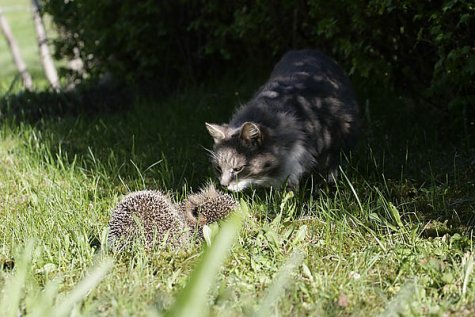Summer generation of hedgehogs
Photo: Arne Ader
Translation: Liis
What are they doing here? Cat inspecting hedgehogs.
| Hedgehog |
Harilik siil
|
Erinaceus europaeus |
The hedgehogs that were born in spring, in May, became independent in July. Hedgehogs can mate during all summer; the gestation period for the female is 5-6 weeks. So the summer litter has been born or is being born, and this is a good time to take a look at their life.
The female hedgehog gave birth somewhere in an out-of-the-way corner, in the city maybe at the compost heap in a garden corner or among last year’s rakings of leaves and twigs. The common size for a litter is four to seven little “barbed wire balls“ but the ten teats of the female hedgehog can accommodate a grander family. The newly-born are pink and blind, some 7 centimetres long little balls. The white, soft and short spines begin growing about one hour after birth. After three weeks the young abandon the nest, but the careful hedgehog mum still continues to suckle her young, and to teach them the ways of proper hedgehog life for another three weeks. Two months old youngsters are already wholly independent; they leave the territory of their parents and start a life of their own.
If there is a suspicion of hedgehogs nesting in the back yard, curiosity should be kept at bay for a while. The first five days are most crucial since the female hedgehog can abandon her nest or even destroy the litter when disturbed. Later the bonding in the litter is so strong that the young will not be abandoned or destroyed, but when disturbed the hedgehog mum will find a new hiding place where she carries her young when darkness falls. And as said, after three weeks when the young leave the nest, their behaviour follows the customary ways of their elders.
What do the grownup relatives look for when they start their foraging rounds as dusk falls? What the hedgehog feasts on can be heard. Slugs or earthworms or grubs or spiders are devoured with smackings. Crackling and snaps: the prey is an insect or a snail with a chitinous shell. Hedgehogs are omnivores, all-eaters: seeds, berries, mushrooms; animal prey may be this summer’s frogs, lizards, reptiles born in late summer, mice if they can be caught or if a nest is found. If there is a water body nearby, dead fish washed up on the shore will do, and also carrion found somewhere in a forest. Scientists have found that the nightly round of hedgehogs is about one kilometre long, and that the males are much faster walkers than the females.
We will look at the wintering of hedgehogs in September. Maybe some industrious people will prepare a winter nest for a hedgehog in a corner in the yard or garden.









